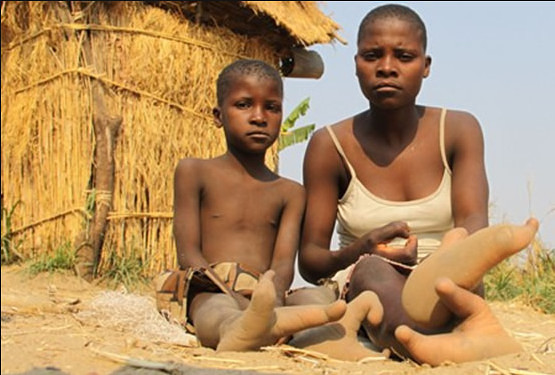Some Doma people in Zimbabwe with distinguishing feature: large toes, which are usually two on each foot and a three-toe feet have accepted their fate. But in the same community, others have normal five feet.
The community, which lives at the boundary of Zimbabwe with Zambia and Mozambique, comprises hardworking people just like the rest in the country. It is believed the ethnic group migrated from Mozambique. But some Doma people argue they once lived in the surrounding mountains.
The community, which occupies the Zambezi River basin, mainly depends on the river for their livelihood. Young and old have learnt fishing using different methods with simple bamboo sticks, strings and hooks.
The toes of Doma people are so big such that those who sport them cannot wear shoes, if they are able to wear a pair of shoes; the villagers buy for them, or are given free footwear.
Surprisingly, some people have normal feet, making a few of those with the two or three-toe feet shy away from them, and interact only with those sporting similar disability.
However, many people who sport the two- toe feet have since accepted their condition. For instance, Rambisai Chinobaiwa, who sports the two-toe feet as is her son Chengetai, says they have become used to living with the condition they have no control over.
The elders of the Vadoma people claim that their remote ancestors were bird like beings who came from the stars and mixed their DNA with early earth women to produce offspring. The elders state that their ancient ancestors came from the star systems of Sirius and first established colonies on a planet within our solar system that they refer to as Liitolafisi.
Sitting outside her home in Kanyemba, Mbire district, with her son, Rambisai says: “We can only accept our situation and thank the ancestors for our life. We are unique and we are okay with that.” Bernard Karumba in his mid-50s, says despite the conditions, many ‘normal’ Doma people are more than ready to marry those with normal feet though his father sported the two-toe feet. His children, too, have normal feet.
However, Karumba says, his father’s disability did not stop his mother from falling in love with him.
“My father had two toes on each foot, and my mother was just like any other normal woman. But they loved each other. This shows how deep our love for each other is. We do not look at many things, but the heart. This was evidenced in the marriage of my parents who managed to accept each other besides their huge differences in physical appearance,” Karumba says, adding: “We can only accept our situation.”
Besides many of the villagers sporting the two-toe feet, the locals are under constant attacks from lions, and many families have lost their loved ones to the beasts.
Local children also risk their lives as they trek long distances to the only school in the area that caters for Grade One to Form Four students.
The locals suspect they might have angered the ancestors who unleashed the lions on them as punishment and think something must be done to appease the ‘angry’ ancestors.
For instance, Karumba tries to explain the many deadly visits by the lions on the villagers: “We suspect that we might have done something wrong to the ancestors who could have caused the lions to pounce on the villagers. We strongly believe in our ancestors and we understand that if we repent our ‘sins’ they will forgive us. We have so far lost many dogs, goats and chickens.”
In fact, he says in the previous year, the villagers gathered at the local administrator’s home where the Chief named only as Chapoto, led them in contributing four goats which were sacrificed to appease the ‘angry’ ancestors. But the attacks are far from being over.
“In the past we used to walk the whole night without any disturbances but now it’s difficult. We love our land… this is the land of our ancestors left for us. And the government must protect us from the wild beasts for we’re a blessing in this land,” Karumba says, adding that he is planning to build a raised wooden thatch house so the beasts could not climb and reach the family.
“We can’t all die. I am planning to build such house so my family can survive,” he says.
According to the Wikipedia, the Doma people, also Vadoma or Wadoma (singular Mudoma), have few contacts with the Bantu majority.
Their two-toed feet is a condition known as ectrodactyly in which the middle three toes are absent and the two outer ones are turned in, resulting in the tribe being known as the “two toed” or “ostrich footed” tribe.
This is an autosomal dominant condition resulting from a single mutation on chromosome number seven. It is reported that those with the condition are not handicapped and well integrated into the tribe. While possibly an aid in tree climbing the condition prevails because of a small genetic pool among the Vadoma and is propagated by the tribal law that forbids members to marry outside the group.
Source- Xinhua news agency

